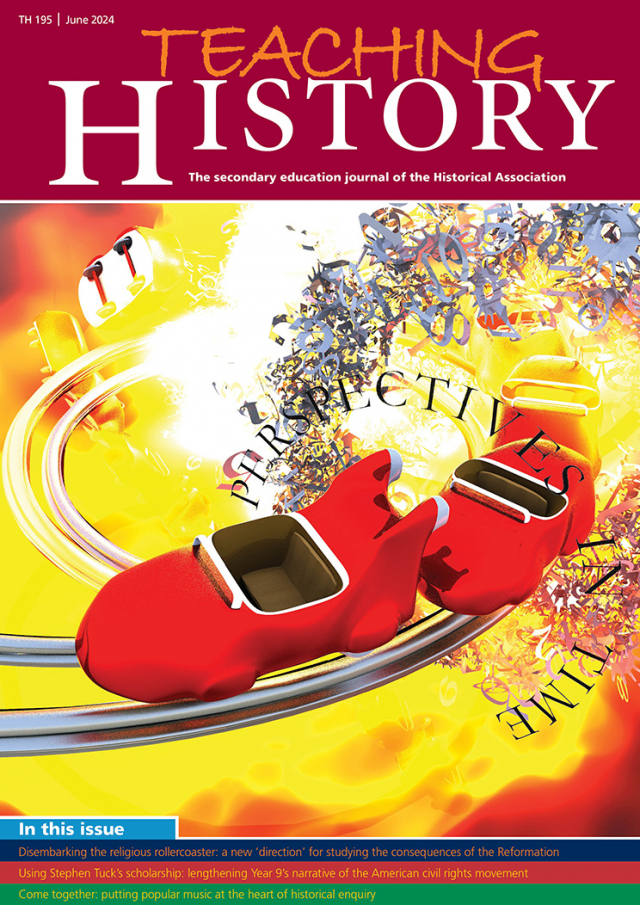Teaching History 195: Out now
The HA's journal for secondary history teachers

Editorial: Perspectives in Time
Read Teaching History 195: Perspectives in Time
In the giant annual ‘card sort’ through which we editors shape numerous article proposals into themes, we found ourselves readily linking the pieces that now fall into this edition. There was a striking commonality; the theme was there. But what should we call it? It was certainly not recognisable by any disciplinary concept. In this edition you will find teachers driving pupils’ argument with all manner of analytic foci: change and continuity, similarity and difference, consequences, evidence, interpretations… All the familiar suspects wander on and off the stage.
No, it was something to do with taking a really long view. It was as though these pieces all highlighted a uniquely historical property of analysis – the temporal.
And there was something else. All the pieces go far more deeply into the texture of a period than high political narratives or the drama of international relations. Such narratives are present and highly consequential, for sure, but authors in this edition are all writing about how they helped their pupils to encounter perspectives and experiences which are discernible in the social, cultural, spiritual and moral fabric of the past. Whatever the stories and sources chosen by these teachers for pupils to connect and explore, we see physical, aural, visual or written sources point to inner spiritual lives or the outward moral action of widely diverse ‘ordinary’ people.
For decades, history teachers have written about the importance of taking the long view. The debate can range from Ian Dawson’s reappearing Cheshire Cat in 1995 and Dale Banham’s ‘overview lurking in the depth’ in 2000 to (much more recently) Nathanael Davies’ determination, in 2021, to keep his students ‘staying with the shot’ as they span a century to examine continuities in oppression within Jamaica. Is there anything left to say? Most certainly. In fact, this edition is testimony to a relentless culture of professional problem-solving, both generally in relation to all history, and specifically, on this issue of taking a long-term perspective on perspective itself.
Sarah Jackson-Buckley and Jessie Phillips were so vexed by their dissatisfaction with their Reformation enquiry that they created a poll on X (formerly Twitter) to see whether other history teachers were having the same problem. They certainly were. Many seemed to be doing a ‘religious rollercoaster’ to handle the sixteen century; few were happy with it. Jackson-Buckley and Phillips found the solution in the fusion of two kinds of scholarship: first, history teachers’ writing on consequences. Their article begins with a closely argued account of how the analytic focus of a consequences enquiry does very different things to the flow and momentum of a lesson sequence from that of a change/continuity enquiry.
Second, historical scholarship. Working in a department that lives and breathes reading and debate of historical scholarship, Jackson-Buckley and Phillips devoured everything from Eric Ives to Barbara Somervill, from Joseph Klaits to Carl Springer. And what did they find all over the scholars’ writing? Metaphor. Ripples, chain reactions, avalanches, snowballs, domino effects and even fermented products.
Following Foster’s work on change and continuity in this journal and elsewhere, the use of metaphor has long been discussed in relation to change/continuity enquiries, but could it be put to service in analysing consequences? It was through examining these metaphors that Jackson-Buckley and Phillips realised that a type of analysis had eluded them. They could have pupils examine the routes by which consequences occurred, thus allowing for a study of all the intriguing deviations that flowed from Luther’s protest in 1517. What is so striking about the piece is the enhanced role that their approach gave to ‘small’ stories. The focus on the complexity of consequence allowed them to widen the geographical and temporal scope of their enquiry, without sacrificing rich depth and detail. Crucially, it became a better way to show pupils how consequences of the Reformation permeated many aspects of society.
Ellie Osborne also took the plunge with a radical new approach. In her case, too, the content both broadened and drilled down. Inspired by Stephen Tuck’s work on black freedom struggles in the USA, Osborne decided that for her Year 9 work on civil rights, she would abandon the conventional reliance on the 1950s and 1960s. Instead, she led her pupils into a vaster story, one going back to the collapse and failure of Reconstruction in the nineteenth century. Through this (and following Tuck), she helped her Year 9 pupils gain insights into the longstanding weight of oppression, both economic and political, and the interplay of collective black agency and temporary gains in power brought by world wars.
David Ingledew broadened his pupils’ perspectives through popular music. In a wide-ranging article, Ingledew has summed up and analysed the multiple functions of popular music, studied both as source and as interpretation. Showing the types of perspective that popular music reveals, Ingledew also provides illuminating examples of how to use the longer story of the origins, genesis, production, promotion and distribution of songs. This has an interesting connection with Maya Stiasny’s approach. She, too, was examining the interpretive process as a longer story. She did so in an effort to help her sixth form students escape from a view of scholarship as a static moment, one that pops out of an historians’ pre-conceived views, rather than something crafted and sitting within a long-term process.
Jane Card’s focus is change and continuity and her substance is attitudes to nineteenth-century policing. Card’s depth of scholarship on visual materials – a lifetime of work in the field, both in the classroom and in the archive – burns through in this shimmeringly visual piece. She offers us a very fresh insight into the distinction between the functions of portraits and cartoons in inviting questions about different types of change in perspective.

